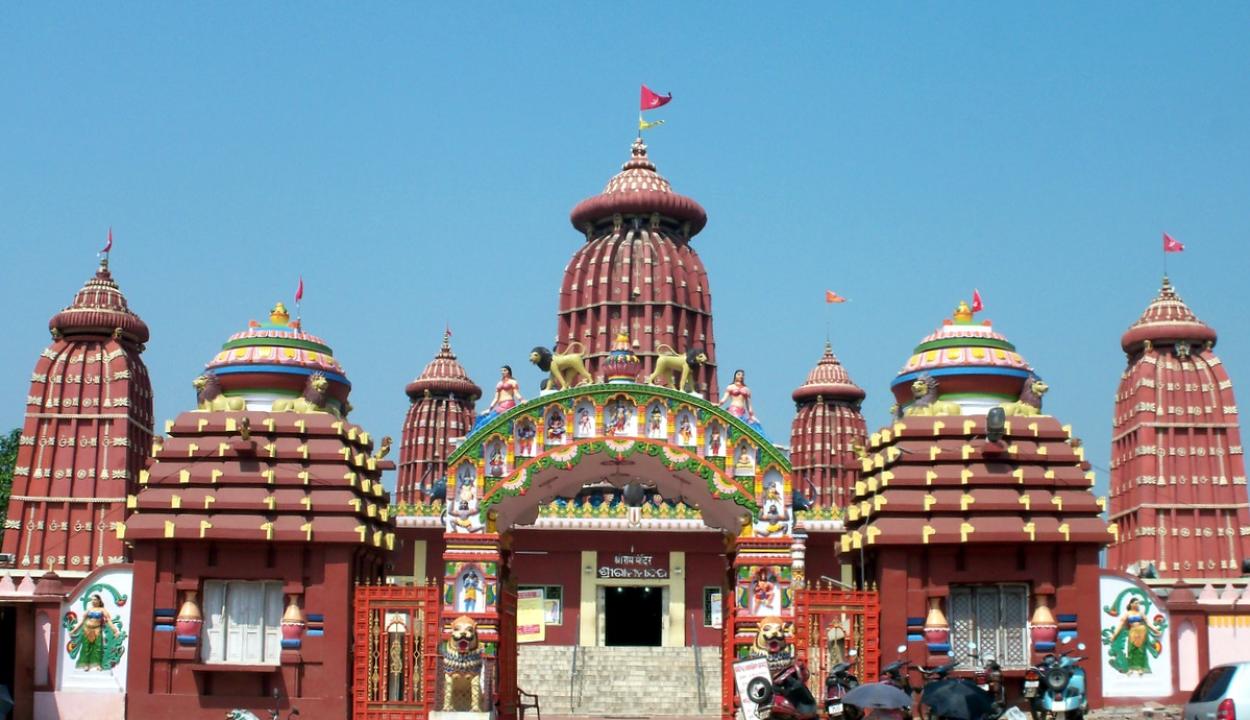Ram Mandir in Bhubaneswar is a spiritual sanctuary and architectural marvel dedicated to Lord Ram. Located near the bustling Janpath area, Ram Mandir Bhubaneswar attracts thousands of devotees and tourists alike, offering an oasis of peace amidst urban life. The temple, adorned with vivid carvings and vibrant structures, is a centre for religious devotion, a cultural landmark, and a site of immense pride for the local community.
In this article, we’ll explore the history, architectural details, religious significance, and visitor highlights of the Bhubaneswar Ram Mandir, one of the city’s most visited temples.
History of Ram Mandir Bhubaneswar
While many temples in Bhubaneswar have deep historical roots, the Ram Mandir in Bhubaneswar is a relatively modern structure, completed in the late 20th century. Built by the Bhubaneswar branch of the Marwari community, the temple serves as a centre of devotion for the followers of Lord Ram, as well as other deities including Lord Shiva, Goddess Sita, and Lord Hanuman. The Marwari community played a key role in constructing the temple, bringing a blend of traditional Hindu temple architecture with contemporary design elements.
Since its completion, Ram Mandir Bhubaneswar has become one of the city’s most cherished places of worship and a site for celebrating major Hindu festivals. The temple’s serene setting, coupled with its spiritual ambience, has made it a popular spot for both locals and tourists.
Architectural Beauty of Bhubaneswar Ram Mandir
The Bhubaneswar Ram Mandir bbsr stands out for its grand architecture, characterized by intricate carvings, towering spires, and vibrant red and white sandstone walls. The temple complex includes multiple shrines, each dedicated to a different deity, with the central sanctum housing idols of Lord Ram, Goddess Sita, and Lord Lakshman. The main sanctum is adorned with sculptures and paintings that depict scenes from the Ramayana, adding to the temple's divine aura.
Spire and Towers: The towering spires of the temple are visible from afar, symbolizing the spiritual ascent toward the heavens. The largest spire marks the central sanctum and is surrounded by smaller spires, each representing a different aspect of Hindu mythology.
Intricate Carvings: The walls of the Ram Mandir feature intricate carvings and motifs that reflect the artistry and devotion of the artisans. Each carving tells a story, whether it’s scenes from the Ramayana, images of divine beings, or decorative patterns representing Hindu symbolism.
Temple Interiors: The interiors of the Ram Mandir are equally captivating, with marble flooring and elaborate decorations that create a serene and meditative atmosphere. The idols of Lord Ram, Sita, and Lakshman are beautifully adorned, and the sanctum is lit with diyas and incense, filling the air with a sacred fragrance.
Religious and Cultural Significance
For the Hindu community in Bhubaneswar, Ram Mandir is not only a place of worship but also a cultural landmark where festivals and religious ceremonies are celebrated with fervour. Some of the most significant events held at Ram Mandir include:
Ram Navami: As the most important festival dedicated to Lord Ram, Ram Navami draws thousands of devotees to the temple. Special prayers, rituals, and celebrations are held, commemorating the birth of Lord Ram. The temple is beautifully decorated with flowers and lights, and religious hymns fill the air, creating a spiritually uplifting experience.
Diwali: The festival of lights is celebrated with grandeur at Bhubaneswar Ram Mandir. The temple is illuminated with countless diyas, and special puja ceremonies are performed. Devotees gather to seek blessings for prosperity and to celebrate the victory of light over darkness.
Dussehra and Navaratri: These festivals mark another peak in temple activities, as devotees participate in pujas, recitals, and other rituals celebrating the victory of good over evil. The temple premises come alive with the sounds of devotional songs and chants, fostering a sense of community and faith.
Hanuman Jayanti: Since Lord Hanuman is one of the revered deities at the temple, Hanuman Jayanti is celebrated with enthusiasm. Devotees pay their respects to Hanuman, who is considered the greatest devotee of Lord Ram, by offering prayers and participating in rituals.
Things to Do and See at Ram Mandir Bhubaneswar
The Ram Mandir in Bhubaneswar offers a variety of activities for devotees and visitors. Beyond offering prayers and participating in ceremonies, there are several features to explore within and around the temple complex.
Meditation and Prayer: The tranquil atmosphere of the Ram Mandir makes it an ideal place for meditation and self-reflection. Many visitors spend time in quiet prayer, finding peace within the sacred environment.
Photography: The temple’s vibrant structure and beautiful surroundings make it a popular spot for photography. Visitors can capture images of the stunning architecture, the towering spires, and the intricate carvings that adorn the temple walls. However, it’s important to be respectful of temple norms and avoid taking photos in prohibited areas.
Evening Aarti: The evening aarti (a Hindu ritual involving the waving of a flame) is a major highlight at Bhubaneswar Ram Mandir. The atmosphere becomes magical as the temple is illuminated by diyas, and the sound of devotional chants and bells fills the air. Witnessing the aarti ceremony is a truly enriching experience, providing a glimpse into the deep spirituality of Hindu worship.
Shopping Nearby: Visitors can also explore the nearby markets, which offer traditional handicrafts, souvenirs, and religious items. The shops around the temple sell statues of deities, incense sticks, and other mementoes that visitors can take home as a memory of their visit.
Best Time to Visit Bhubaneswar Ram Mandir
The Ram Mandir Bhubaneswar can be visited year-round, but the winter months from October to February offer the most pleasant weather, making it an ideal time to explore. The temple is especially lively during Hindu festivals, particularly Ram Navami, Diwali, and Dussehra when devotees gather in large numbers to celebrate. Visiting during these times allows you to experience the temple in its full spiritual and festive splendour.
Location and Accessibility
Located centrally in Bhubaneswar on Janpath Road, Ram Mandir is easily accessible by public transportation, taxis, and auto-rickshaws. Bhubaneswar has a well-connected railway station and an airport, making it convenient for visitors from other cities and states.
Tips for Visiting Ram Mandir Bhubaneswar
Dress Modestly: As a place of worship, it’s important to dress conservatively when visiting Ram Mandir. Avoid clothing that may be considered inappropriate or disrespectful.
Remove Footwear: Visitors are required to remove their footwear before entering the temple premises. Designated areas are available for storing shoes and slippers.
Respect Temple Norms: Photography may be restricted in certain areas, so be sure to follow temple rules. Maintain silence in the main sanctum and refrain from disturbing those in prayer.
Best Time for Aarti: If you want to witness the evening aarti, arrive early to secure a good spot. The aarti is a popular attraction, and the temple can get crowded during this time.
Conclusion
The Ram Mandir in Bhubaneswar stands as a testament to the devotion, artistry, and cultural heritage of Odisha. With its magnificent architecture, serene atmosphere, and religious significance, the temple is a must-visit for anyone travelling to Bhubaneswar. Whether you’re a devout follower of Lord Ram, an admirer of Hindu architecture, or simply a traveller in search of spiritual peace, the Bhubaneswar Ram Mandir offers a soul-stirring experience.
A visit to this sacred site allows you to witness the depth of Hindu traditions and provides an opportunity to engage with the rich cultural fabric of Bhubaneswar. Plan your visit to Ram Mandir Bhubaneswar and immerse yourself in the beauty and spirituality of this iconic temple, a true gem in the city’s heart.


